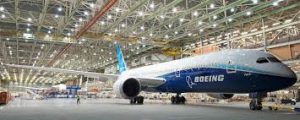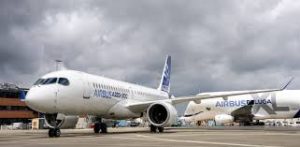
A new aerospace study suggests America’s aviation industry will find challenging times in the coming year and it will have a direct impact on the nearly 37,000 aerospace workers in central Oklahoma and the 230 aerospace firms in the region. And oil prices will play a role in whether some aerospace firms are profitable.
The study by AlixPartners, a global consulting firm says challenges will arise not because of the Boeing 737 MAX crisis.
The study found that the top 100 listed A&D companies experienced record growth last year of 8.6% increase in revenues, the highest annual growth rate of the decade and sustained strong profitability of10.6% in earnings before interest and taxes, or EBIT.
Boeing, with regional operations next to Tinker Air Force Base and Airbus delivered 1,606 commercial aircraft which was 8 percent higher than 2017. Both had healthy passenger and cargo traffic.
However, 2019 has already seen several clouds gathering across key A&D market segments, says the study, including:
- In commercial aircraft, while the long-term impact of the 737 MAX crisis is not yet clear, it is already negatively impacting Boeing and the whole aerospace supply chain and could also lead to new certification requirements. Regaining the trust of passengers will be critical, says the study, and this crisis may also impact Boeing’s long-awaited new mid-market airplane, or “NMA.”
- Several “cracks” have appeared in the commercial-aircraft supply chain in recent years— in the cabin, engine, and aerostructure sectors in particular. These cracks have drawn attention to the fragility of the industrial chain set-up at current production rates, and how the chain needs to be strengthened to sustain the higher production rates needed to clear record backlogs in narrowbody aircraft.
- Volatile oil prices, volatility in international trade, and rising non-fuel costs are hurting airline profitability globally, as reflected in the recent 20% decline in the International Air Transport Association’s (IATA) profit forecast for airlines for 2019.

Beyond these industry factors, a new opportunity—and threat—for industry participants is the continued rise of digital technologies, says the report. These technologies can potentially help industry players to stay ahead of the competition and better anticipate customer and public needs, but they are adding another layer of complexity to an already complex business environment, such as:
- The rising awareness of the environmental impact of aviation, driving the industry towards more fuel-efficient propulsion technologies, including hybrid and electrical aircraft.
- The fact that in many ways the digital revolution has already begun, such as the example of platforms like Airbus’s Skywise gaining traction with airlines. The first-movers who adopt smart digital solutions will enjoy a long-term advantage, says the report.
In the defense segment of the industry, the study raises several questions, including:
- The United States’ defense budget is projected to increase by nearly 5% in 2020, totaling $7.18 billion, and then by another 4% per year for the next four years after that. This sustained increase in funding levels aligns with the 2018 US National Defense Strategy to fund requirements needed for step-function technology development. Can the US defense industry execute to increases in requirements for advanced technologies, such as for hypersonic and C4ISR (the Command, Control, Communications, Computers, Intelligence, Surveillance, and Reconnaissance concept) capabilities?
- Can the defense sector globally keep up with increasing end-user expectations on affordability and sustainability, especially given tighter “time-to-battlefield” requirements?
- Will the efforts of the past 18 months to build a European defense policy around the Future Combat Air System (FCAS), Euro-MALE (medium-altitude long-endurance drones), and European Defense Fund bear fruit in today’s complicated European political environment?
- How far can Europe progress towards a needed consolidation of platforms and industry players in order to be ready to execute next-generation weapon systems?
At the same time, M&A activity in the A&D industry overall continued apace in 2018, says the study, with nearly $126 billion spent on 436 transactions. It also finds that the 10 largest transactions of the year totaled approximately $73 billion, just slightly lower than the 2017 total. While a break from mega-deals might have been expected this year, to allow the digestion of the major 2018 transactions, 2019 may be yet another record year for such deals, says the study. The recent announcement of the United Technologies-Raytheon merger, with an estimated combined market value of close to $166 billion, not only rocked the industry but may also trigger more transactions ahead, as smaller players try to consolidate, says the study.
Eric Bernardini, global leader of the Aerospace, Defense & Airlines practice at AlixPartners and a managing director at the firm, said: “The 737 MAX crisis has shone a spotlight on an industry performing well, but one contending with inherently tough issues. Despite strong performances across the board of late, with increased budgets and passenger numbers, industry participants could be in for a rough ride in the coming years. This impending turbulence is a result of diminished consumer trust, due in large part to safety issues; the sustainability of supply chains as currently configured; rising input costs; and an increasing focus on the environment from outside the industry. With the technological revolution hitting this industry, and the pace of change quickening, there will be a definite first-mover advantage, which will also likely include entirely new entrants as the industry reconfigures itself for the future.
“All this is set against a backdrop of further global economic slowdown, meaning the year ahead will be a challenging one. However, with every threat, an opportunity is also presented for the industry to evolve and improve by doing such things as proactively anticipating activist-investor interventions, seizing smart M&A opportunities, and preparing for the next wave of technological change. It is vital that management teams undertake proactive transformations of their companies by revisiting their business portfolio and continuing to innovate, rather than waiting to become victims of the larger trends sweeping the industry.”
Click here to read more details.





